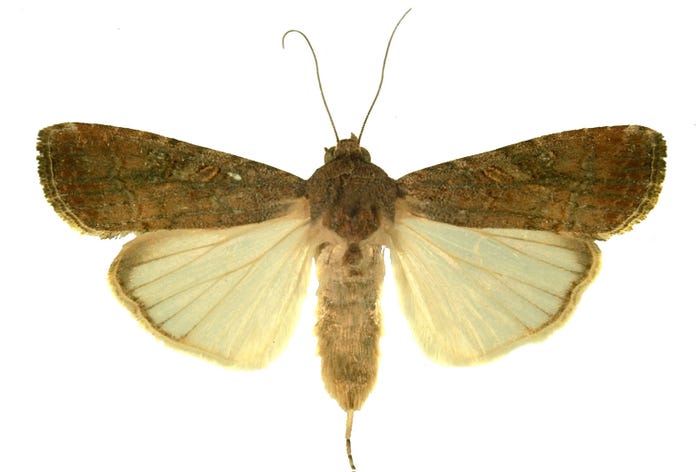
After last year’s fall armyworm outbreak — the worst in 30 years — farmers need to know when and where insects are moving in their area, and the Missouri Pest Monitoring Network can help.
University of Missouri Integrated Pest Management offers the Missouri Pest Monitoring Network, which provides free text alerts to notify farmers when insects are active in their locations. This year, MU Extension entomologist Kevin Rice says there are six key insects affecting agricultural crops:
Japanese beetle
brown marmorated stinkbug
black cutworm
corn earworm
fall armyworm
true armyworm
In late May, specialists trapped corn earworms in southeast Missouri and fall armyworms in the northwest region of the state, Rice says. Once pests alerts have been sent for an area, farmers need to get out and inspect their own fields for pest pressure.
Corn earworm damage
Corn earworms typically appear in April and produce multiple generations throughout the growing season.
The presence of the moths indicates that fields in the region should be scouted for corn earworms, but the moths’ presence doesn’t necessarily mean that the field needs treatment, Rice says. Moths are buff-colored with irregular wing markings and a wingspan of 1½ inches, according to MU’s IPM website.

Corn earworm larvae causes damage to the crop by feeding on silks. It is distinguished by its black spines.
The larvae typically feed at the tip of the corn ears, cotton squares and bolls, and soybean pods and seeds. Small larvae are cream-colored, but larger ones vary in color from pale green to rose to brown.
What differentiates them is corn earworm larvae have numerous small, black spines along their back and sides. Once a larva is full-grown, it crawls down the host plant and pupates in the soil. The next generation of moths emerges within the next 10 to 25 days. For more information, visit the Missouri Pest Monitoring Network corn earworm page.
Finding fall armyworm
After last year’s infestation, farmers are familiar with fall armyworm and understand the damage it causes to crops and pastures.
The fall armyworm moths usually migrate north to Missouri in late May. Late-planted corn is more attractive to fall armyworm moths, Rice says.
Fall armyworms are a periodic pest in Missouri that feed on more than 100 plant species but prefer lush, green pastures and fields, with brome and alfalfa as favorites. They do not overwinter in Missouri, but they survive in Gulf Coast states and migrate north as moths on air currents and can fly more than 1,000 miles.

When farmers see fall armyworm moths flying around their fields, it is a good indicator of a problem with this pest. Pay attention to its translucent wings. Last year, both crops and pastures were inundated with fall armyworms.
Moths have a noticeable white spot near the extreme end of each forewing. The hind wing appears iridescent silver-white with a narrow dark border.
Larvae color ranges from off-white to light tan or pinkish gray as larvae mature, according to the Missouri Pest Monitoring Network fall armyworm guide. It has a smooth skin, free of hairs, with round dark spots scattered over top and sides with a dark brown to black head. It only reaches 1 inch in length.
Be careful in dry years as signs of an armyworm infestation can be confused with drought damage. As the worms feed on the tender top leaves, the field is left with a brown appearance.
Armyworms are named for the way they quickly “march” through a field, consuming all of the vegetation in their path. They avoid feeding in the heat of the day, so scouting should be done in the early morning or evening.
Thresholds for treatment of armyworms start when three or more half-inch larvae are present per square foot. However, larvae larger than 1.5 inches are nearing pupation, so control is not recommended.
For more information on the fall armyworm, visit IPM Missouri Pest Monitoring Network fall armyworm page.
Get on the list
To stay in the know on insect movement around your farm or across the state, and subscribe to alerts for any or all listed insects, visit ipm.missouri.edu or email [email protected].
University of Missouri Extension contributed to this article.
About the Author(s)
You May Also Like






